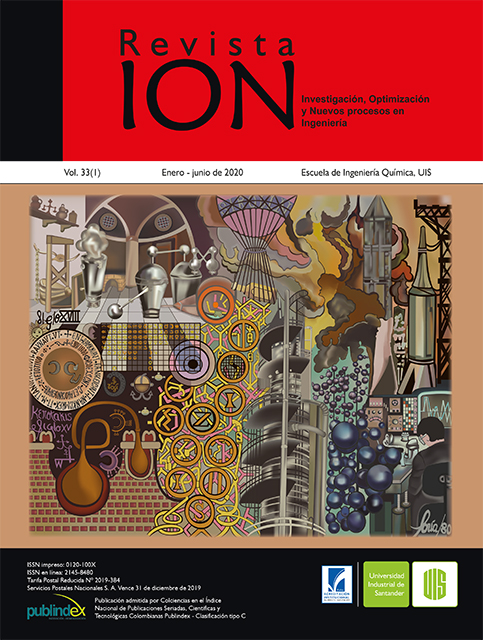Projeto fatorial 2k para a otimização da síntese de nanopartículas de prata com aplicação em biomateriais
Publicado 2020-06-30
Palavras-chave
- Nanopartículas de Prata,
- Biomaterial,
- Antimicrobiano,
- Projeto Fatorial,
- Otimização
Como Citar
Resumo
As nanopartículas de prata (AgNPs) são uma alternativa para o uso dos antibióticos, devido a suas propriedades antimicrobianas e bactericidas; ditas nanopartículas, devem ter uma geometria e um tamanho adequado para que as propriedades sejam melhoradas. Para observar quais fatores influenciam na geometria e no tamanho, foi realizado um projeto fatorial 24 variando os seguintes fatores: temperatura de síntese, concentração de nitrato de prata (agente precursor), porcentagem de citrato trissódico (agente redutor) e álcool polivinílico (PVA) (agente dispersante). As nanopartículas obtidas foram avaliadas por UV-Vis, TEM e DLS. A partir dos resultados, uma análise de variância (ANOVA) foi realizada no software estatístico Rstudio e foi otimizado no centurião STATGRAPHIC XVII. Como resultado, foi obtido um tamanho de AgNPs entre 6 e 100 nm, onde foi demostrado que a porcentagem de PVA não influencia na síntese, enquanto outros fatores como temperatura, porcentagem de citrato trissódico, concentração nitrato de prata e a interação entre eles, influenciam o tamanho final das partículas. Para a otimização das AgNPs, foi escolhido um tamanho de 20 nm para o qual é relatada uma maior capacidade antimicrobiana. Conclui-se que, para obter a forma e o tamanho adequado, devem ser cumpridas as seguintes condições: temperatura de 90 °C, concentração de nitrato de prata 0,13 M e concentração de citrato de trissódio 10 %.
Downloads
Referências
[2] Seil JT, Webster TJ. Antimicrobial applications of nanotechnology: methods and literature. Int. J. Nanomed. 2012;7:2767–81.
[3] Guzman M, Dille J, Godet S. Synthesis and antibacterial activity of silver nanoparticles against gram-positive and gram-negative bacteria. Nanomedicine. 2012;8(1):37-45.
[4] Zhang JP, Chen P, Sun CH, Hu XJ. Sonochemical synthesis of colloidal silver catalysts for reduction of complexing silver in DTR system. Applied Appl. Catal., A. 2004;266(1):49-54.
[5] Patel K, Kapoor S, Dave DP, Mukherjee T. Synthesis of nanosized silver colloids by microwave dielectric heating. J. Chem. Sci. 2005;117(1):53-60.
[6] Pal S, Tak YK, Song JM. Does the antibacterial activity of silver nanoparticles depend on the shape of the nanoparticle? A study of the gram-negative bacterium Escherichia coli. Appl. Environ. Microbiol. 2007;73(6):1712–20.
[7] Benedí J. Apósitos. Farmacia Profesional. 2006;20(6):52-6.
[8] Amarís MR, Rojas JB, Batista AG, Chaparro CG, García JP, Rodríguez LV. Factores asociados al pie diabético en pacientes ambulatorios. Centro de Diabetes Cardiovascular del Caribe. Barranquilla (Colombia). Salud Uninorte. 2012;28(1):65-74.
[9] Zhao L, Wang H, Huo K, Cui L, Zhang W, Ni H, Zhang Y, Wu Z, Chu PK. Antibacterial nano-structured titania coating incorporated with silver nanoparticles. Biomaterials. 2011;32(24):5706-16.
[10] Farzin L, Sadjadi S, Shamsipur M, Sheibani S, hasan Mousazadeh M. Employing AgNPs doped amidoxime-modified polyacrylonitrile (PAN-oxime) nanofibers for target induced strand displacement-based electrochemical aptasensing of CA125 in ovarian cancer patients. Mater. Sci. Eng., C. 2019;97:679-87.
[11] Dadashpour M, Firouzi-Amandi A, Pourhassan-Moghaddam M, Maleki MJ, Soozangar N, Jeddi F, Pilehvar-Soltanahmadi Y. Biomimetic synthesis of silver nanoparticles using Matricaria chamomilla extract and their potential anticancer activity against human lung cancer cells. Mater. Sci. Eng., C. 2018;92:902-12.
[12] Mogoşanu GD, Grumezescu AM. Natural and synthetic polymers for wounds and burns dressing. Int. J. Pharm. 2014;463(2):127-36.
[13] Hebeish A, El-Rafie MH, El-Sheikh MA, Seleem AA, El-Naggar ME. Antimicrobial wound dressing and anti-inflammatory efficacy of silver nanoparticles. Int. J. Biol. Macromol. 2014;65:509-15.
[14] Ding L, Shan X, Zhao X, Zha H, Chen X, Wang J, Yu G. Spongy bilayer dressing composed of chitosan–Ag nanoparticles and chitosan–Bletilla striata polysaccharide for wound healing applications. Carbohydr. Polym. 2017;157:1538-47.
[15] Levi-Polyachenko N, Jacob R, Day C, Kuthirummal N. Chitosan wound dressing with hexagonal silver nanoparticles for hyperthermia and enhanced delivery of small molecules. Colloids Surf., B. 2016;142:315-24.
[16] Bozaci E, Akar E, Ozdogan E, Demir A, Altinisik A, Seki Y. Application of carboxymethylcellulose hydrogel based silver nanocomposites on cotton fabrics for antibacterial property. Carbohydr. Polym. 2015;134:128-35.
[17] Rubina MS, Kamitov EE, Zubavichus YV, Peters GS, Naumkin AV, Suzer S, Vasil’kov AY. Collagen-chitosan scaffold modified with Au and Ag nanoparticles: Synthesis and structure. Appl. Surf. Sci. 2016;366: 365-71.
[18] Carmona MER, da Silva MAP, Leite SGF. Biosorption of chromium using factorial experimental design. Process Biochem. 2005;40(2):779-88.
[19] Enis IY, Sezgin H, Sadikoglu TG. Full factorial experimental design for mechanical properties of electrospun vascular grafts. J. Ind. Text. 2018;47(6):1378-91.
[20] Montgomery DC. Design and analysis of experiments. United States: John wiley & sons; 2017.
[21] Gallo Ramirez JP, Ossa Orozco CP. Fabricación y caracterización de nanopartículas de plata con potencial uso en el tratamiento del cáncer de piel. Ing. Desarro. 2019;37(1):88-104.
[22] Ananda AP, Manukumar HM, Krishnamurthy NB, Nagendra BS, Savitha KR. Assessment of antibacterial efficacy of a biocompatible nanoparticle PC@ AgNPs against Staphylococcus aureus. Microb. Pathog. 2019;126:27-39.
[23] Ahila NK, Ramkumar VS, Prakash S, Manikandan B, Ravindran J, Dhanalakshmi PK, Kannapiran E. Synthesis of stable nanosilver particles (AgNPs) by the proteins of seagrass Syringodium isoetifolium and its biomedicinal properties. Biomed. Pharmacother. 2016;84:60-70.
[24] Khatoon UT, Rao GN, Mohan KM, Ramanaviciene A, Ramanavicius A. Antibacterial and antifungal activity of silver nanospheres synthesized by tri-sodium citrate assisted chemical approach. Vacuum. 2017;146:259-65.
[25] Morales J, Morán J, Quintana M, Estrada W. Síntesis y caracterización de nanopartículas de plata por la ruta sol-gel a partir de nitrato de plata synthesis and characterization of silver nanoparticles by sol-gel route from silver nitrate. Rev. Soc. Quim. Peru. 2009;75(2):177-84.
[26] Wei A. Plasmonic nanomaterials. En Nanoparticles. Springer, Boston, MA. 2004. pp. 173-200.
[27] Sifontes AB, Melo L, Maza C, Mendes JJ, Mediavilla M, Brito JL, Zoltan T, Albornoz A. Preparation of silver nanoparticles in the absence of polymer stabilizers. Quim. Nova. 2010;33(6):1266-9.
[28] Velázquez-Velazquez JL, Santos-Flores A, Araujo-Meléndez J, Sánchez-Sánchez CV, González C, Martínez-Castañon G, Martinez-Gutierrez F. Anti-biofilm and cytotoxicity activity of impregnated dressings with silver nanoparticles. Mater. Sci. Eng., C. 2015;49:604-11.


